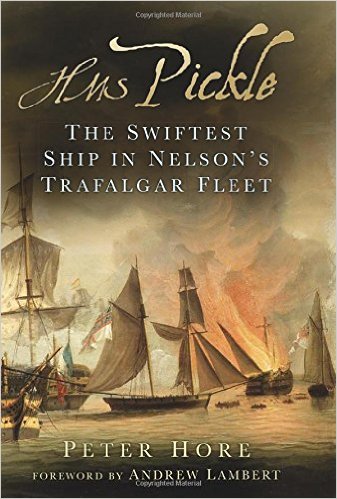HMS Pickle: The Swiftest Ship in Nelson’s Fleet at Trafalgar
Peter Hore
 HMS Pickle was the second-smallest British warship at Trafalgar. Pierced for 14 guns, this schooner was part of the anonymous swarm of small vessels populating the Royal Navy during the Napoleonic Wars. Except for HMS Pickle being picked to carry the post-battle dispatches (and news of Nelson’s death), it would be completely forgotten today.
HMS Pickle was the second-smallest British warship at Trafalgar. Pierced for 14 guns, this schooner was part of the anonymous swarm of small vessels populating the Royal Navy during the Napoleonic Wars. Except for HMS Pickle being picked to carry the post-battle dispatches (and news of Nelson’s death), it would be completely forgotten today.
HMS Pickle: The Swiftest Ship in Nelson’s Trafalgar Fleet at Trafalgar,” by Peter Hore, tells the history of the ship and its various crews. It is a slim but interesting volume about a minor but significant vessel.
Hore actually tells the story about the first two Royal Navy warships named Pickle. In the first decade of the nineteenth century the Royal Navy briefly had two ships simultaneously named Pickle. Both were schooners, both came from the West Indies, and both were active at the same time. Hore unsnarls the resulting confusion by relating the history of both ships.
The focus is on the Trafalgar Pickle. A fascinating story it proves. This Pickle was launched in 1799 under the name Sting. Built in Bermuda it was a schooner, with foreand-aft sails on both masts. Schooners are common sailing vessels today, but the Royal Navy then considered them experimental. Hore describes how the ship was purchased in the West Indies station in 1800, renamed Pickle and used to carry dispatches.
Hore not only describes the ship’s history, but also describes those who impinged on the ship. The list includes the woman who would become Lady Hamilton (well before that date), Lord Hugh Seymore (who could potentially have rivaled Nelson had he not died of Yellow Jack), and Michael Fitton (whose exploits were retold in fictional form by Showell Styles).
Beyond the prominent and eccentric, Hore also relates the lives of the men and officers who served on Pickle. Hore gives a face to the typical mariners who manned the Royal Navy of the period, both before the mast as sailors and on the quarterdeck as officers.
Herein lies the fascination. Pickle’s moment of glory came after Trafalgar, when it carried Admiral Collingwood’s report of the battle to the Admiralty. Its captain was a 35-year-old lieutenant, capable, but previously luckless. He made the most of his opportunity, racing other ships, and avoiding superior officers to be the first with the news. Hore describes the consequences of both success and failure in the race. Yet the majority of his career and Pickle’s career fell outside that brief moment of fame. Hore describes that as well, both the tedium and the danger. The book is less a story about Trafalgar than of life on the little vessels in the Royal Navy during the age of fighting sail.
- Annapolis: Naval Institute Press, 2015
- 5-1/4” x 8”, hardcover, 192 pages
- Illustrations, bibliography, index. $34.95
- ISBN: 978-0750964357
Reviewed by Mark Lardas, League City, Texas
